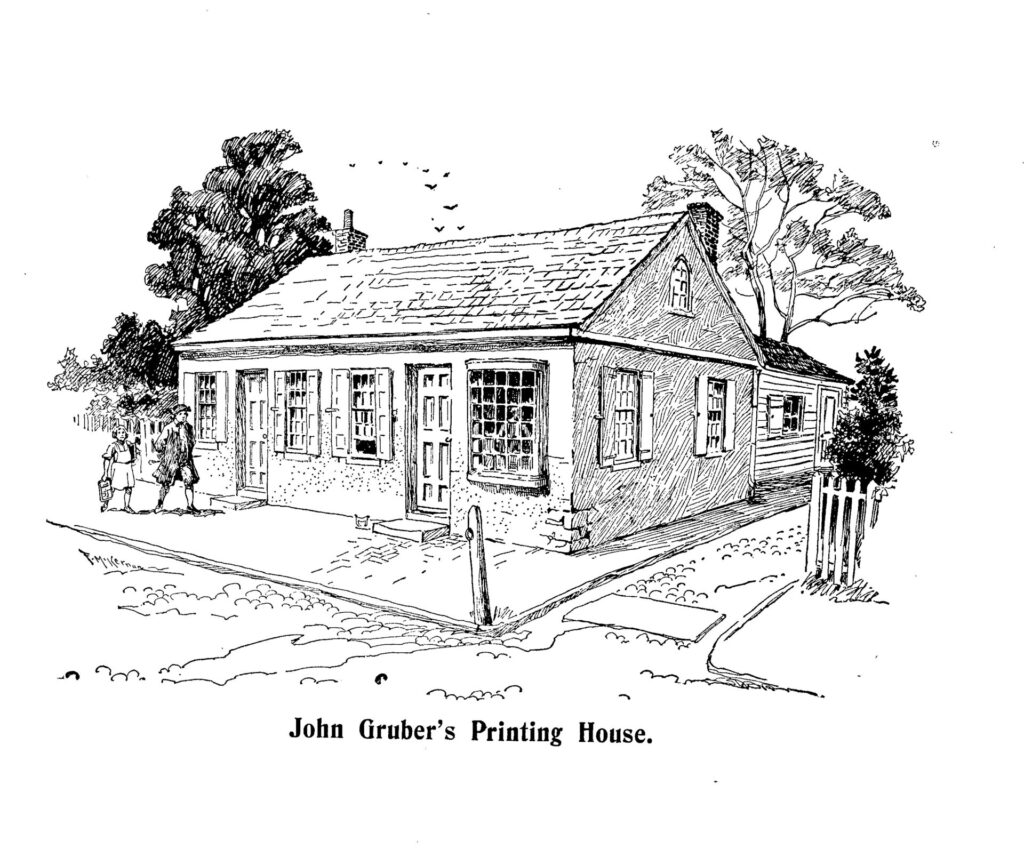A page of wisdom passed down through generations said a rural home required only two books. The first was a Bible to help prepare for the next life, and the second was a Farmer’s Almanac to assist with an earthly life.
Originating in Europe, yearly almanacs became a treasured resource throughout American history. In Pennsylvania, Franklin County’s namesake started “Poor Richard’s Almanack” in 1732 Philadelphia, a publication that offered now-famous witticisms to its readers. Some of Ben Franklin’s philosophies are still quoted today: “A penny saved is a penny earned.” Despite its fame and popularity, Poor Richard’s ceased publication in 1758.
Franklin’s almanac inspired others. At age 15, a son of German immigrants named Johann (John) Gruber apprenticed to the printing trade. During his internship in Philadelphia, Gruber attended Benjamin Franklin’s funeral procession. Later, after exploits at sea, he started a newspaper in Reading, Pa., before arriving in Hagerstown in 1795 to launch a new printing operation.
Gruber set up shop on South Potomac Street. With his new enterprise, he performed every task required – he sold advertising, made his own printable paper and typeset the publication by hand. Gruber’s son-in-law, Daniel May, later became his business partner.
For the first edition in 1797, the Hagerstown Town & Country Almanack (spelled with an ending ‘k’ because that was the German spelling) was printed solely in German. In 1822, Gruber added an English-language version. Those dual bilingual editions lasted until 1917 when anti-German sentiment flared in America during World War I, and the German edition ended.

Like Ben Franklin, Gruber added notes of wisdom to his almanack, offered seasonal weather forecasts and printed practical household tips, complimented by amusing wordplay. His almanack gained steady popularity, and that content is still the hallmark of the publication today.
Gruber was a prolific worker. One of his mottos during his life was: “By industry we thrive.” During his printing career, Gruber also published dozens of books, mostly with religious themes. He was also the first to publish Francis Scott Key’s poem about Fort McHenry, which later became the National Anthem.
Gruber trained others in the printing business, and he worked at his trade until age 87. He died two years later in 1857. Gruber was remembered as a civic-minded family man who always offered kind words to everyone he met.
After Gruber’s death, his widow, Catherine, became the publication’s editor, the first female almanack executive in the United States. Later, two of Gruber’s daughters took the reins as the almanack continued into the 1900s. The business has remained in the family ever since.
Gruber started an enterprise still in existence today, now the 51st oldest business in the U.S. The Hagerstown Town & Country Almanack is the second oldest almanac still printed in the country. The “Old Farmer’s Almanac,” started in 1792, is based in New Hampshire. But Hagerstown’s edition is the only publication still edited by a direct descendant of its founder. Current editor Charles Fisher Jr. is the great-great-great-great grandson of John Gruber.

One of the most anticipated aspects of the almanack is its yearly weather forecasts. As autumn transitions to winter, many people want to know how severe the winter will be and when to anticipate the spring planting season.
The almanack has used a series of weather prognosticators throughout its 227-year history who used various tools and information to make detailed predictions. This diverse collection of men traditionally kept their methodology a closely guarded secret.
The first prognosticator, known as the “Blacksmith Astronomer”, was Charles Flack, who served from 1797 to 1825. Later, the father and son duo of Lawrence and Will Ibach were the chief weather predictors for the almanack between 1862 and 1918. The seventh man who calculated the weather served the longest, and is held in the highest esteem.
His name is William O’Toole III, a Waynesboro native who became a professor of computer science at Mount St. Mary’s University. O’Toole started with the almanack in 1969, and over many years earned a reputation for uncanny accuracy in predicting weather. He used specialized software and computing power to analyze sunspot activity and track phases of El Nino and La Nina weather cycles, among other observations.

O’Toole retired in 2021 after 52 years and passed the torch to a new generation. But he holds the title of Almanack Prognosticator Emeritus and remains closely associated with the publication’s weather program. After his collegiate retirement, O’Toole was also honored as a Professor Emeritus by Mount St. Mary’s.
The eighth and current weather prognosticator is Chad Merrill, the first meteorologist employed by the almanack. Merrill is the chief meteorologist for WOAY-TV in West Virginia and also works for WTOP Radio in Washington, D.C. Inside the 2025 edition, Merrill details the 12 mini-seasons of the Mid-Atlantic region and he predicts less than average snowfall and warmer than normal temperatures this winter.
However, for the Christmas season, Merrill foresees “dry then breezy with a heavy rain/snow mix” for December 21-25. The last five days of 2024 will bring local weather that is “seasonably cold with periods of light snow.” He expects a White Christmas west of Interstate 81.
The format and art design of the almanack has changed little over the years. The quarto edition size initiated by Gruber in 1797 lasted until 1965 when a slightly smaller easier-to-handle edition was unveiled. However, the content has increased to 84 pages, as the first editions were only 29 pages in length. Most of the design is identical to original 1790s copies.
The 2025 edition has all the first-rate content of prior almanacks. Departments such as Farm & Garden, Poultry Notes, Dairy & Livestock and Hints for the Homemaker, offer useful tips. In the “Favorites” section, readers will find Health Hints, Medical Notes and the best days for planting, weeding and harvesting. One eye-catcher is a section titled “Let Aunt Lydia Predict the Sex of Your Next Child.”
Jerry Spessard is the Hagerstown Town & Country Almanack’s business/sales manager, and has worked at the publication for more than 40 years. He says distribution became challenging in recent years with fewer mom and pop local outlets. The almanack will publish 30,000 copies this year. In contrast, the almanack had a circulation of more than 200,000 in the early 1900s.
Spessard views his position as a family and public trust, keeping the almanack viable into the next generation. He recalls many conversations with the publication’s fans, including one woman who called to inquire if the moon was in the correct phase to cut her toenails.
Another couple told Spessard they argued about when to plant grass in their yard. So one side was planted according to the almanack’s preferred timeframe (the wife’s idea), while the other half was planted on the husband’s intuition. The wife won the argument when the almanack-planted grass thrived, and the husband’s didn’t.

In recent years, new almanack content was added, including original poetry from readers, tips for fishermen, a listing of state birds and flowers, a “Table of Weights and Measures” and “Designs for Living,” a section that helps readers in their pursuit of happiness. These new departments add to the almanack’s flavor without diminishing its charming persona. Even the cover price is a throwback to another era, this year only $5.95.
Over two centuries, the Hagerstown Town & Country Almanack has developed a stellar reputation as an entertaining and valuable resource for farmers, gardeners and inquisitive minds. The publication followed John Gruber’s philosophy of providing useful information mixed with inspiring content. The result is a tradition that is both nostalgic and timeless.
As the holidays approach and 2025 is eagerly anticipated, John Gruber’s wisdom is found in the almanack that has flourished since 1797: “To give of yourself is perhaps the most precious gift of all.”



















